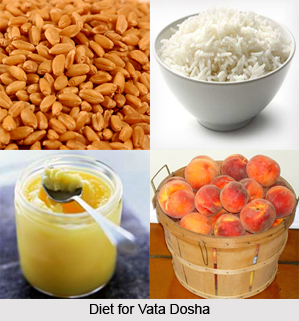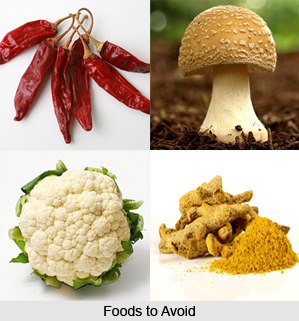 Ayurveda recommends that a person should be very careful about his eating habits. One should not eat foods, which aggravates the dosha, which is dominant in the person. People with a predominant vata dosha are very active, restless and energetic. These kind of people usually have fast metabolisms, so are often thin with little muscle development and protruding joints that may make cracking noises. It can be said that the best quality of vata dosha is rough, dry, cold and subtle. Thus, diet for vata dosha should incorporate warm, moist, oily, soft and heavy foods.
Ayurveda recommends that a person should be very careful about his eating habits. One should not eat foods, which aggravates the dosha, which is dominant in the person. People with a predominant vata dosha are very active, restless and energetic. These kind of people usually have fast metabolisms, so are often thin with little muscle development and protruding joints that may make cracking noises. It can be said that the best quality of vata dosha is rough, dry, cold and subtle. Thus, diet for vata dosha should incorporate warm, moist, oily, soft and heavy foods.
Foods to Include in Diet
A person with vata dosha should consume vata pacifying food. Vata can be pacified with nutritive and tissue-building foods. The foods should taste sweet, sour and salty. Soft dairy products like ghee and grains like oat, wheat, rice are also recommended for a person with vata dosha. Hot cereals with ghee, healthy soups with vegetables are ideal food for such persons.
Vegetables like asparagus, carrots, green beans, bhindi, cucumber, onions, garlic, radish, beets and sweet potatoes are good for such persons.
 Fruits like apricots, banana, cherries, fresh figs, peaches, citrus fruits, dates, mango, papaya, grapes, berries, pineapple, and plums can be eaten. Beverages like warm drinks, herbal or spiced teas, warm milk, fruit and vegetable juice without ice can be good option for vata dosha people.
Fruits like apricots, banana, cherries, fresh figs, peaches, citrus fruits, dates, mango, papaya, grapes, berries, pineapple, and plums can be eaten. Beverages like warm drinks, herbal or spiced teas, warm milk, fruit and vegetable juice without ice can be good option for vata dosha people.
Foods to Avoid
There are certain foods, which should be completely avoided as they aggravate the vata dosha. Frozen deserts and large amounts of raw vegetables and salads should be avoided. Foods, which have a pungent, bitter, astringent taste, should be avoided. Cold, dry and light food should also not be taken.
Foods made of refined white flour and sugar are said to have light and dry quality and should be avoided. Vegetables, which should be avoided, include, cabbage, cauliflower, brinjal, leafy green vegetables, peas, mushroom, capsicum, sprouts, tomatoes, celery and potatoes enhances vata dosha and therefore should be avoided.
Smoking, consuming alcohol, junk food, brown rice and tea prepared with long leaves should be kept off. Vata dosha people should not consume fruits like apples, pears and pomegranates. Dry and hot spices like dried chilli, turmeric, methi seeds, saffron and dhaniya (coriander) powder should be avoided.




















